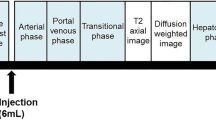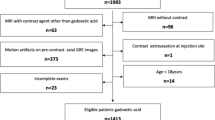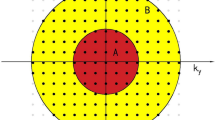Abstract
Purpose
To establish if triple-phase arterial imaging improves the detection of arterial phase hyperintense lesions based on arterial phase capture, motion artifact degradation, and lesion enhancement when compared to single-phase imaging.
Materials and methods
Patients at risk for hepatocellular carcinoma were imaged at 3.0T. Seventy-three consecutive patients with a standard single-phase MRI and eighty-five consecutive patients were imaged using extracellular contrast with triple arterial phase MRI using three sequential accelerated acquisitions of 8 s. Arterial phase capture and image quality were qualitatively categorized. Forty single-phase and forty-four triple-phase studies contained arterially enhancing lesions > 1 cm with washout appearance. The contrast-to-noise ratio (CNR) of the lesions was calculated. We compared the differences in means with Student t-tests and those in arterial phase capture with a Chi squared test with Yates correction.
Results
The triple-phase acquisitions captured the early or late arterial phases more frequently than did the single-phase acquisition (99% vs 86%; P value = 0.006). Triple-phase also provided greater number of patients with early or late arterial phase imaging without motion artifact (92% vs 79%, P-value = 0.05). The lesion analysis revealed increased maximum CNR in the triple-phase imaging (704.4) vs. single-phase imaging (517.2), P-value < 0.001.
Conclusion
Triple-phase acquisition provides more robust arterial phase imaging for hepatic lesions, with increased lesion CNR, compared to standard single-phase arterial phase imaging.




Similar content being viewed by others
References
Jemal A, Bray F, Center MM, et al. (2011) Global cancer statistics. CA Cancer J Clin. 61:69–90
Mittal S, El-Serag HB (2013) Epidemiology of hepatocellular carcinoma: consider the population. J Clin Gastroenterol. 47(Suppl):S2–S6
Cruite I, Tang A, Sirlin CB (2013) Imaging-based diagnostic systems for hepatocellular carcinoma. Amer J Roentgenol. 201:41–55
Wald C, Russo MW, Heimbach JK, et al. (2013) New OPTN/UNOS policy for liver transplant allocation: standardization of liver imaging, diagnosis, classification, and reporting of hepatocellular carcinoma. Radiology 266:376–382
Lee YJ, Lee JM, Lee JS, et al. (2015) Hepatocellular carcinoma: diagnostic performance of multidetector CT and MR imaging-a systematic review and meta-analysis. Radiology 275(1):97–109
Murakami T, Kim T, Takamura M, et al. (2001) Hypervascular hepatocellular carcinoma: detection with double arterial phase multi-detector row helical CT. Radiology 218:763–767
Ichikawa T, Kitamura T, Nakajima H, et al. (2002) Hypervascular hepatocellular carcinoma: can double arterial phase imaging with multidetector CT improve tumor depiction in the cirrhotic liver? AJR Am J Roentgenol. 179:751–758
Yoshioka H, Takahashi N, Yamaguchi M, et al. (2002) Double arterial phase dynamic MRI with sensitivity encoding (SENSE) for hypervascular hepatocellular carcinomas. J Magn Reson Imaging. 16:259–266
Pietryga JA, Burke LMB, Marin D, Jaffe TA, Bashir MR (2014) Respiratory motion artifact affecting hepatic arterial phase imaging with gadoxetate disodium: examination recovery with a multiple arterial phase acquisition. Radiology 271:426–434
Hope TA, Saranathan M, Petkovska I, et al. (2013) Improvement of gadoxetate arterial phase capture with a high spatio-temporal resolution multiphase three-dimensional SPGR-Dixon sequence. J Magn Reson Imaging. 38:938–945
Saranathan M, Rettmann DW, Hargreaves BA, Clarke SE, Vasanawala SS (2012) DIfferential Subsampling with Cartesian Ordering (DISCO): a high spatio-temporal resolution Dixon imaging sequence for multiphasic contrast enhanced abdominal imaging. J Magn Reson Imaging. 35:1484–1492
Hope TA, Petkovska I, Saranathan M, Hargreaves BA, Vasanawala SS (2015) Combined parenchymal and vascular imaging: High spatiotemporal resolution arterial evaluation of hepatocellular carcinoma. J Magn Reson Imaging.
Rosset A, Spadola L, Ratib O (2004) OsiriX: an open-source software for navigating in multidimensional DICOM images. J Digit Imaging. 17:205–216
Kim S, Mussi TC, Lee LJ, et al. (2013) Effect of flip angle for optimization of image quality of gadoxetate disodium-enhanced biliary imaging at 1.5 T. Am J Roentgenol. 200:90–96
Vogl T, Stupavsky A, Pegios W, et al. (1997) Hepatocellular carcinoma: evaluation with dynamic and static gadobenate dimeglumine-enhanced MR imaging and histopathologic correlation. Radiology 205:721–728
Mori K, Yoshioka H, Takahashi N, et al. (2005) Triple arterial phase dynamic MRI with sensitivity encoding for hypervascular hepatocellular carcinoma: comparison of the diagnostic accuracy among the early, middle, late, and whole triple arterial phase imaging. AJR Am J Roentgenol. 184:63–69
Liver Imaging Reporting and Data System (LI-RADS). American college of radiology. http://www.acr.org/Quality-Safety/Resources/LIRADS. Accessed 18 Feb 2014.
Davenport MS, Viglianti BL, Al-Hawary MM, et al. (2013) Comparison of acute transient dyspnea after intravenous administration of gadoxetate disodium and gadobenate dimeglumine: effect on arterial phase image quality. Radiology 266:452–461
Sharma P, Kalb B, Kitajima HD, et al. (2011) Optimization of single injection liver arterial phase gadolinium enhanced MRI using bolus track real-time imaging. J Magn Reson Imaging. 33:110–118
Earls JP, Rofsky NM, DeCorato DR, Krinsky GA, Weinreb JC (1997) Hepatic arterial-phase dynamic gadolinium-enhanced MR imaging: optimization with a test examination and a power injector. Radiology 202:268–273
Frydrychowicz A, Nagle SK, D’Souza SL, Vigen KK, Reeder SB (2011) Optimized high-resolution contrast-enhanced hepatobiliary imaging at 3 tesla: a cross-over comparison of gadobenate dimeglumine and gadoxetic acid. J Magn Reson Imaging. 34:585–594
Reeder SB, Wintersperger BJ, Dietrich O, et al. (2005) Practical approaches to the evaluation of signal-to-noise ratio performance with parallel imaging: application with cardiac imaging and a 32-channel cardiac coil. Magn Reson Med. 54:748–754
Author information
Authors and Affiliations
Corresponding author
Ethics declarations
Funding
No grant funding was used in this study.
Conflict of interest
Nabia S. Ikram, Judy Yee, Stefanie Weinstein, Benjamin M. Yeh, Carlos U. Corvera, Alexander Monto and Thomas A. Hope declare that they have no conflict of interest.
Ethical approval
All procedures performed in studies involving human participants were in accordance with the ethical standards of the institutional and/or national research committee and with the 1964 Helsinki declaration and its later amendments or comparable ethical standards.
Informed consent
The need for individual informed consent was waived by our institutional review board (IRB) for this retrospective study.
Rights and permissions
About this article
Cite this article
Ikram, N.S., Yee, J., Weinstein, S. et al. Multiple arterial phase MRI of arterial hypervascular hepatic lesions: improved arterial phase capture and lesion enhancement. Abdom Radiol 42, 870–876 (2017). https://doi.org/10.1007/s00261-016-0948-8
Published:
Issue Date:
DOI: https://doi.org/10.1007/s00261-016-0948-8




